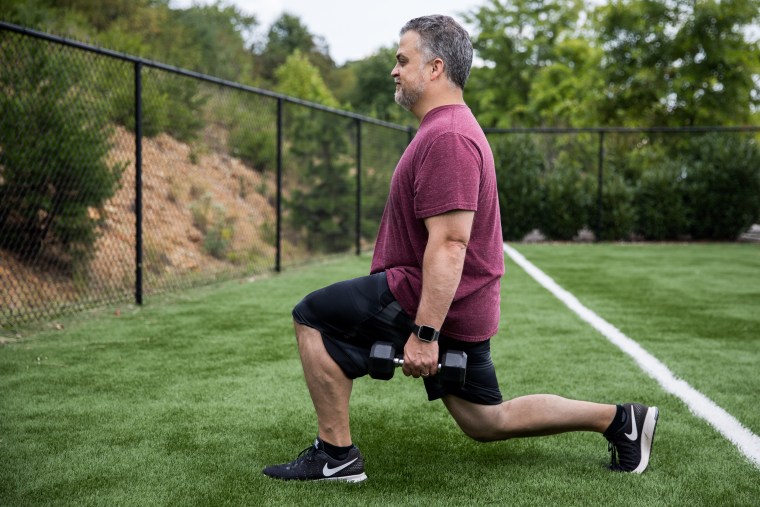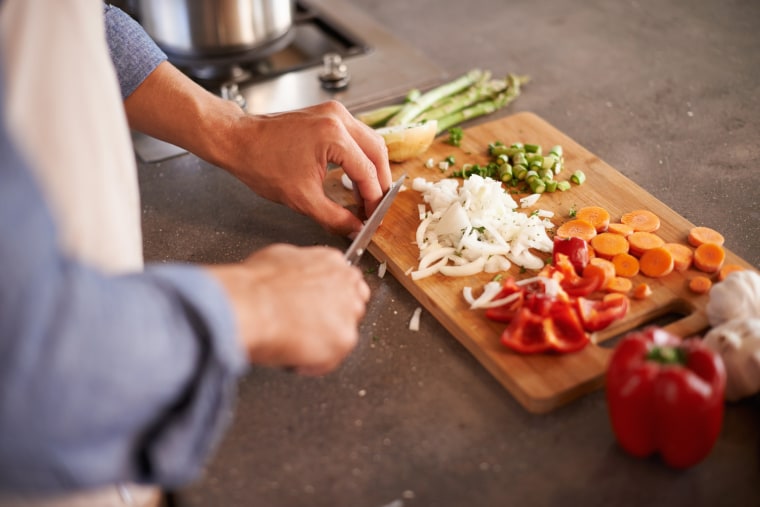I am tackling a big health challenge: I’ve dedicated myself to following the federal Dietary Guidelines and Physical Activity Guidelines for a full year. As expected when attempting to institute new habits into a routine, embarking on this challenge came with a little trial and error.
To prepare for day one of my year-long commitment, I looked at my typical breakfasts, lunches and snacks to determine optimal combinations. I had to keep my calories within the parameters of the protein, fat and carbohydrate ratios that I had set as my goal, so my daily targets were 2,500 calories, 312 grams of carbohydrate, 188 grams of protein and 56 grams of fat.
To keep myself organized, and honest, I spent most of a day creating Excel spreadsheets to map out “perfect” days.
In the process of doing this, I came to the conclusion that this was the wrong approach and that I was going to have to figure things out on the fly each day. After all, who wants to pick out their meals every day based on a spreadsheet? And how sustainable is that in the long run, especially when you factor in the cravings and whims of your family members? Unless I wanted to cook a meal for one every day, I would have to find a better way to incorporate eating more healthfully into my lifestyle — and make it a habit that sticks. Here are the best lessons I learned along the way:
Lesson: Stay focused, but flexible
Deciding to be flexible became an essential element of success in the early weeks of my new lifestyle. Instead of trying to map out “optimal” days of eating, I simply stuck with the healthier breakfast and lunch choices from my list. I stocked up on proteins to cook over the first week or so, including boneless, skinless chicken breast, chicken thighs, red snapper and lean cuts of beef. This empowered me to decide what to eat for dinner depending on my mood while choosing from a list of options I knew would keep me on track.
Another key was finding substitutes for the less healthy foods that had become habits for me. A lot of eating is the comfort that certain “treats” can provide. Cutting them out completely would be difficult and make it more likely that I would go back to bad habits. For instance, before starting this project, I indulged in an ice cream bar every evening. They were delicious, but each bar contained 170 calories, 12 grams of fat, 17 grams of carbohydrate and 2 grams of protein. Because it was part of my evening routine that I enjoyed, it would have been hard to completely cut it out.
I found an alternative that has 80 calories, 5 grams of fat, 7 grams of carbohydrate and 3 grams of protein. Granted, it doesn’t taste nearly as good, but if it’s the only option in the house, I won’t be tempted by the higher calorie bar, and I’d get to continue with doing something that I enjoyed.

Lesson: Create the environment to succeed
I once wrote an article for the American Council on Exercise about optimizing your environment for success through something called choice architecture. Essentially, this involves removing “bad” options from your immediate environment at the times when you will be making crucial decisions, or, to phrase that more positively, encouraging good decisions by having healthier options more readily available.
How much more likely might you and your family be to eat fruit if it’s washed and in a bowl on the kitchen table? Would you be less likely to eat an unhealthy snack if it was kept in a designated drawer in the kitchen that you had to make the conscious decision to open in order to make an unhealthy choice?
Choice architecture involves encouraging good decisions by having healthier options more readily available.
Removing the higher-fat ice cream treat from my house and replacing it with a healthier option that still satisfies my evening craving for sweets has eliminated decision making and willpower from the equation. It’s important to remember that willpower is a limited resource, so minimizing how often you have to use it in order to be successful is absolutely essential.
Lesson: Learn to Focus on the Big Picture
One of the things I found most interesting about the first four weeks of this project were the fluctuations in weight loss. I lost 8.9 pounds over the course of the month, but take a look at my weekly totals:
- Week 1: –3.6 pounds
- Week 2: –1.1 pounds
- Week 3: –0.7 pounds
- Week 4: –3.5 pounds
Ordinarily, back-to-back weeks with the disappointing weight-loss results I saw in weeks 2 and 3 might have derailed my efforts. I can easily imagine myself thinking, “I’m not working this hard to lose a pound or less each week!”
Of course, this isn’t really about weight loss. It’s about improving my health through ongoing lifestyle change. It’s about consistent application of better choices over time. Putting too much credence into the number on the scale on any given morning is a bad idea, as there are so many factors involved in determining what you weigh at a specific moment in time.
In addition, making a shift in body composition by losing fat and gaining muscle is a long-term and decidedly nonlinear process. The body adapts and shifts your metabolism in phases, so fluctuations are to be expected. It’s also important to remember that if you’ve been gaining weight prior to making a change to your lifestyle, then maintaining your weight over the course of a week indicates that you’ve halted the negative health trend, which is a tremendously important achievement.
Over the course of this first month, I averaged 2,325 calories per day, 278 grams of carbohydrate (50 percent), 58 grams of fat (22 percent) and 172 grams of protein (30 percent), which is almost perfectly in line with my goals. [Note that the macronutrient percentages don’t add up to 100 percent. This is because food manufacturers are legally allowed to fudge the numbers a bit by rounding up or down to suit their needs.] What I thought was going to be a project centered on planning and crunching the numbers turned out to be more about flexibility and the ability to follow less-healthy days with healthier ones in order to bring my numbers into balance over time.
Lesson: Look at each morning as a new chance
Another tip? Embrace the process. It’s often hard to embrace change, particularly when the results of that change aren’t immediately revealed. At times, it may seem like your efforts are fruitless, and in those moments, it’s important to embrace the process of personal growth you’re going through and not just the end result.
In the early days of this project, I quickly learned that “the daily reset” was a great motivator for me. It may be a well-worn cliché, but living one day at a time really has been an eye-opening experience.
Give yourself a fresh start each morning and recognize that even a small victory for that day is a victory.
Each morning, whether I had a perfect day the previous day or got tripped up when the basket of bread and saucer of olive oil and pesto arrived at the restaurant table, I start with a clean slate. I know exactly what I need to eat to hit my daily goal and exactly how many minutes I have to spend doing cardio or lifting weights to stay on track for the week. This immediately releases me from any guilt associated with not eating as well as I should have for a day, and frees me from dwelling on my small successes and failures in a way that in the past may have sent me spiraling back down to inactivity or eating poorly.
Give yourself a fresh start each morning and recognize that even a small victory for that day is a victory.
So what are you waiting for?
I’m proud that NBC News BETTER invited me to share my journey with you through the completion of The Lifestyle Project and beyond, and now I want to hear from you.
Have questions about my journey? Ask me on Twitter from noon to 1 p.m. EST Thursday, September 21.
WANT TO EAT BETTER TODAY? TRY THESE SIMPLE SWAPS:


